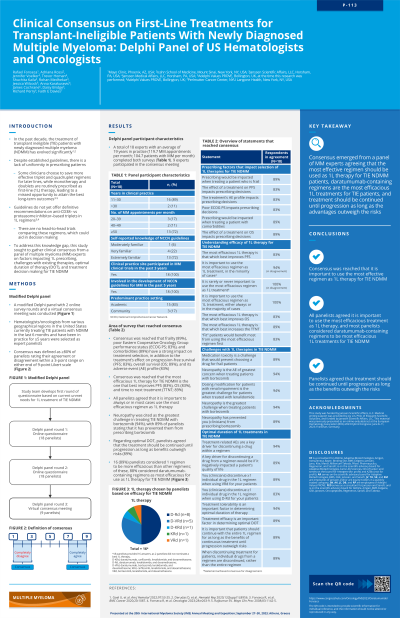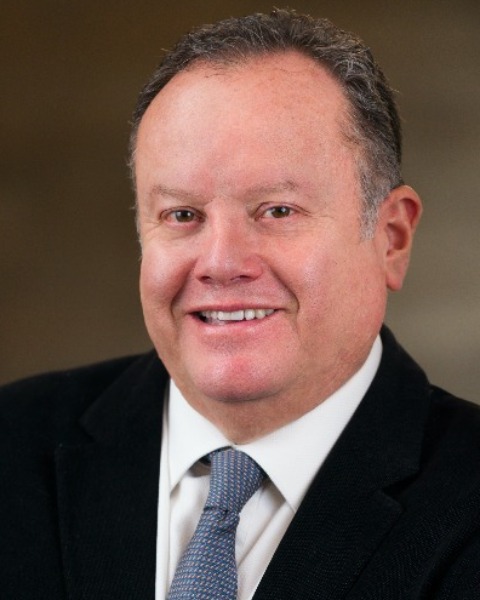Treatment of Newly Diagnosed Myeloma - Non-Transplant Eligible
Poster Session 1
P-113: Clinical Consensus on First-Line (1L) Treatments for Transplant-Ineligible (TIE) Patients With Newly Diagnosed Multiple Myeloma (NDMM): Delphi Panel of US Hematologists and Oncologists
Wednesday, September 27, 2023
1:30 PM - 2:30 PM EEST


Rafael Fonseca, MD
Chief Innovation Officer
Division of Hematology/Oncology, Mayo Clinic, Phoenix, AZ, USA
Phoenix, Arizona, United States
Introduction: In the past decade, the treatment of transplant ineligible (TIE) patients with newly diagnosed multiple myeloma (NDMM) has evolved significantly. However, despite established guidelines there is a lack of uniformity in prescribing patterns. Triplets are still reserved for later lines, while monotherapy and doublets with inferior efficacy are routinely prescribed as 1L therapy, leading to a missed opportunity to attain the best long-term outcomes. Moreover, guidelines do not offer definitive recommendations on anti–CD38- vs proteasome inhibitor-based triplets in 1L, and there are no head-to-head (H2H) trials comparing these regimens which could aid in decision making. To address this knowledge gap, this study sought to gather clinical consensus from a panel of multiple myeloma (MM) experts on factors impacting 1L prescribing, challenges with existing therapies, optimal duration of therapy (DoT), and treatment decision making for TIE NDMM.
Methods: A modified Delphi Panel with 2 online survey rounds and a virtual consensus meeting was used. US-based hematologists/oncologists who treat TIE NDMM patients were selected as expert panelists. To reach consensus, ≥80% of panelists had to rate their agreement/disagreement within a 3-point range on either end of 9-point Likert scale. The panel was double blinded to maintain the validity of the study and to prevent bias.
Results: Eighteen experts with an average of 18.8 years in practice (119.7 MM appointments/month; 104.7 patients with MM/month) completed both surveys; 9 of them participated in the consensus meeting. Consensus was reached that, in addition to the treatment's effects on progression-free survival (PFS), overall survival (OS), and its adverse event profile, frailty (89%), poor ECOG score (83%), and comorbidities (89%) have a strong impact on treatment selection. All panelists concurred that it is important to always or in most cases use the most effective regimen (one that best improved PFS and OS) as 1L therapy. Sixteen (89%) panelists considered one regimen to be more efficacious than other regimens; of these, 88% considered daratumumab (D), lenalidomide (R), dexamethasone(d) (DRd) or D-containing quadruplet (quad) regimens as most efficacious for use as 1L therapy for TIE NDMM. Neuropathy was cited as the greatest challenge in treating TIE NDMM with bortezomib (V; 94%), with 89% of panelists stating that it has prevented them from prescribing V. Regarding optimal DoT, panelists agreed that the treatment should be continued until progression as long as benefits outweigh risk (89%).
Conclusions: A panel of MM experts reached clinical consensus that it was important to utilize the most effective regimen as 1L therapy for TIE NDMM. Most panelists agreed that DRd or D-containing quad regimens were the most effective 1L treatment for TIE NDMM. In the absence of absence of H2H trials among current triplet and quad regimens, these findings may help physicians with decision making.
Methods: A modified Delphi Panel with 2 online survey rounds and a virtual consensus meeting was used. US-based hematologists/oncologists who treat TIE NDMM patients were selected as expert panelists. To reach consensus, ≥80% of panelists had to rate their agreement/disagreement within a 3-point range on either end of 9-point Likert scale. The panel was double blinded to maintain the validity of the study and to prevent bias.
Results: Eighteen experts with an average of 18.8 years in practice (119.7 MM appointments/month; 104.7 patients with MM/month) completed both surveys; 9 of them participated in the consensus meeting. Consensus was reached that, in addition to the treatment's effects on progression-free survival (PFS), overall survival (OS), and its adverse event profile, frailty (89%), poor ECOG score (83%), and comorbidities (89%) have a strong impact on treatment selection. All panelists concurred that it is important to always or in most cases use the most effective regimen (one that best improved PFS and OS) as 1L therapy. Sixteen (89%) panelists considered one regimen to be more efficacious than other regimens; of these, 88% considered daratumumab (D), lenalidomide (R), dexamethasone(d) (DRd) or D-containing quadruplet (quad) regimens as most efficacious for use as 1L therapy for TIE NDMM. Neuropathy was cited as the greatest challenge in treating TIE NDMM with bortezomib (V; 94%), with 89% of panelists stating that it has prevented them from prescribing V. Regarding optimal DoT, panelists agreed that the treatment should be continued until progression as long as benefits outweigh risk (89%).
Conclusions: A panel of MM experts reached clinical consensus that it was important to utilize the most effective regimen as 1L therapy for TIE NDMM. Most panelists agreed that DRd or D-containing quad regimens were the most effective 1L treatment for TIE NDMM. In the absence of absence of H2H trials among current triplet and quad regimens, these findings may help physicians with decision making.
